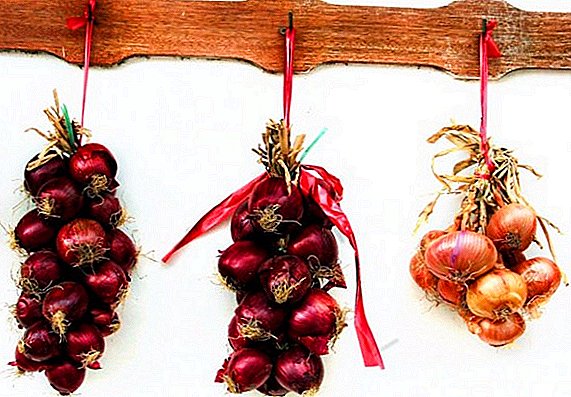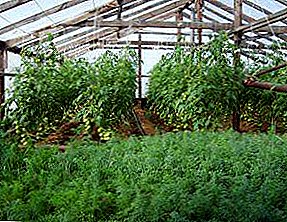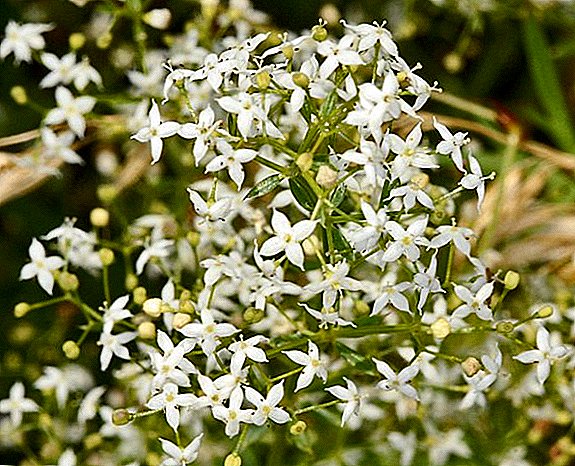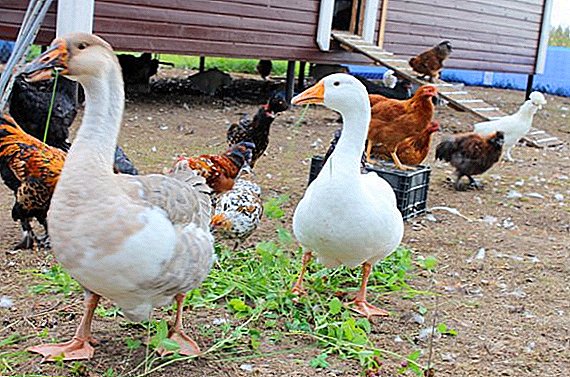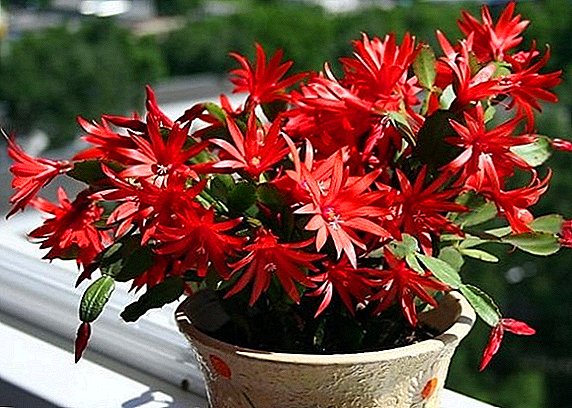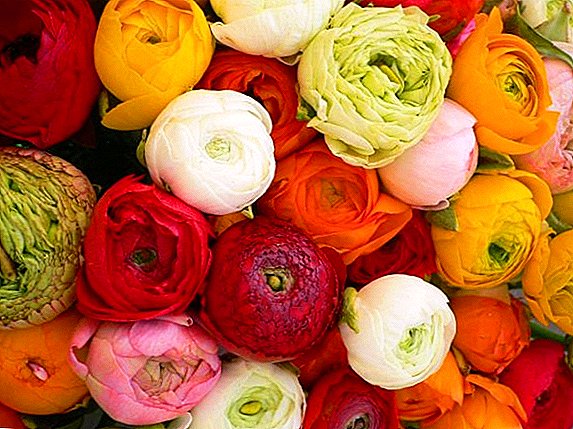 One of the most beloved flowers of gardeners and florists is garden ranunculus or as it is called "buttercup". It has many different color variations, and therefore allows you to roam design fantasy.
One of the most beloved flowers of gardeners and florists is garden ranunculus or as it is called "buttercup". It has many different color variations, and therefore allows you to roam design fantasy.
Types of garden ranunculus
Everything types of buttercups conditionally can be divided into two main groups:
- stalky or African, the flowers of which are shaped like a peony;
- Persian, which is shaped like a rose bud.
Did you know? Ranunkulyus is also called the "Asian Buttercup" because it came to us from Asia Minor. In the XVI century from Turkey, he came to England, where he immediately aroused great interest. At the end of the 19th century, its popularity was noticeably diminished, but nowadays the plant relives a wave of interest from gardeners. Spherical flowers 8-10 cm in diameter with a stem 15-50 cm tall can stand cut in water for up to two weeks.
Nuts and bolts
 The plant belongs to the family of buttercups, therefore, it has biological, morphological and agrotechnical characteristics of cultivation characteristic of this family.
The plant belongs to the family of buttercups, therefore, it has biological, morphological and agrotechnical characteristics of cultivation characteristic of this family.
Optimum landing time
If the tubers are planted through seedlings, then it should be laid at the beginning of spring, and if you plan to plant immediately in open ground, then this is done at the beginning of May. That is, the bulbs of the plant, as well as the seedlings are planted only when the risk of sudden spring frosts disappears. In general, the question, "How to plant a ranunculus?" It has a simple solution if you know the basic rules of this process.
How to choose a place for landing
The plant grows well in partial shade, although it feels good in the bright sun. But in light shade, flowers grow brighter, larger and do not fade for a long time, and it is important to find a place where there will not be a constant strong wind, but there will be enough heat.
How to prepare the tubers
To prepare the tubers for planting, they are placed for several hours in a humid environment. This may be moss, wet sawdust or a sponge, with which they are moistened with water or a solution of potassium permanganate. Sometimes For better growing season, a special growth stimulant is added. Some gardeners recommend wrapping the tubers with a rag soaked in Appin solution. In this case, they are kept in this state for no more than six hours. During this time, they manage to get enough of the necessary moisture, without drawing in extra liquid, due to which the roots start to rot over time.
How to prepare the soil
 The plant grows well in light, neutral, fertile soil. This may be black soil with humus or sand, or peat with chalk to neutralize the high acidity. It is absolutely impossible to plant buttercups in loam. It is important that the earth does not detain moisture, but at the same time absorbs it well during irrigation. Therefore, it is necessary to select a soil that is drained, warm and rich in humus with an interval of medium reaction between pH 5-8. The groundwater level must be at least one and a half meters.
The plant grows well in light, neutral, fertile soil. This may be black soil with humus or sand, or peat with chalk to neutralize the high acidity. It is absolutely impossible to plant buttercups in loam. It is important that the earth does not detain moisture, but at the same time absorbs it well during irrigation. Therefore, it is necessary to select a soil that is drained, warm and rich in humus with an interval of medium reaction between pH 5-8. The groundwater level must be at least one and a half meters.
Do not forget about the drainage, otherwise the roots will rot. At the bottom of the pit you need to pour a little sand. The soil itself also requires preparation. Before planting, they dig it with compost and a solution of foundationol.
Scheme and depth of landing
Planting buttercups with tubers has its own characteristics. So, we must bear in mind that the plant does not tolerate transplants, so the place must be chosen in advance, after weighing everything well. To plant the tubers, for them to dig a hole and placed at a depth of 5-8 cm. Between them maintain a distance of 10-15 cm, and from the top fall asleep with sand or loose soil. If there is a chance of frosts, then instead of sand you can use straw or other covering material. At first, watering should be scant so as not to rot the roots. Usually, the first peduncles appear in two or three months, respectively, the time when the ranunculus is in bloom is about the middle of summer.
Proper care is the key to good flowering of the ranunculus.
As practice shows, out of 10 purchased tubers of buttercups, only 6-7 take root, and only half of them bloom out of flowers. The problem is that Buttercup roots very quickly lose moisture, and are also subject to hazards in the first couple of weeks of growth. Therefore, to increase the chances of getting a flowering plant, you need to know when to plant the buttercups, and also how to care for them during growth.
Did you know? Translated from Latin, Ranunculus means "frog", and he received such a name for the fact that some of its species like to settle in the marshland. In Italy, the plant is called “the golden buttons of the meadows,” and some retell the legend of how Jesus turned little stars into flowers and presented them to his mother as a sign of love. People unfamiliar with gardening people call buttercups miniprops or minipions. Today, experts have more than 600 species of plants.
Watering and feeding the soil
 Ranunkulyus need to be watered regularly, but a little. As already mentioned, an excess of moisture leads to rotting of the roots. Externally, this problem is determined by dropping the buds and the appearance of mold on the leaves. To deal with this trouble is quite simple. It is necessary to reduce watering, remove damaged roots and loosen the soil around the plant.
Ranunkulyus need to be watered regularly, but a little. As already mentioned, an excess of moisture leads to rotting of the roots. Externally, this problem is determined by dropping the buds and the appearance of mold on the leaves. To deal with this trouble is quite simple. It is necessary to reduce watering, remove damaged roots and loosen the soil around the plant.
Feed buttercups should be once every two weeks. For this, potash fertilizers are used at the rate of 40 g per square meter of soil. During planting and during flowering, it is recommended to add ash, potassium sulfate or potassium salt to the soil. As support, mullein or complex fertilizers are used.
Weeding and loosening the soil
The technique of growing plants is simple. In addition to proper watering and removal of flowering peduncles, mulch is used. It is also necessary to regularly loosen the soil so that the roots of the plant are well ventilated and not rotted.
Care for buttercups at home is similar, with the only difference being that regular weeding of the flower bed in this case is not relevant. For growing a flower on the balcony, it is recommended to plant several types of buttercups in one pot in order to create a beautiful composition. It is advisable to place the pot on the east or west side. But if it is on the south side, then you will have flowering as long as possible. In the question "How to grow ranunculus at home?", Not only the topic of regular watering and feeding, but also spraying the plant is relevant.
Pruning
 It is important to time pruning of flowering inflorescences, because the plant produces flower stalks very thick and they can interfere with new flowers. From cut stalks form bouquets and put them in the water, where they are able to stand for at least two weeks.
It is important to time pruning of flowering inflorescences, because the plant produces flower stalks very thick and they can interfere with new flowers. From cut stalks form bouquets and put them in the water, where they are able to stand for at least two weeks.
Digging and storage of tubers
This stage of gardening is carried out after the plant ottsvetet and prisohnet. How long does a ranunculus bloom? In the middle lane, he pampers us with flowers from the end of May to the beginning of August - as soon as the heat sets, but before the heat even begins. However, digging up the tubers only after the leaves of the plant have completely dried, regardless of the month of the year. Before this, it is necessary to cut off its dry leaves and stems. When digging up the tubers, be very careful, as they are fragile and brittle.
Important! At its core, ranunculus is a perennial plant, but in open ground, at temperatures below -7ºC, it dies. Therefore, in the winter it is placed in the basement, where the temperature is kept at + 4 ... +6 ºC.After digging up the tubers, it is advisable to stand for half an hour in the foundation or 15-20 minutes in a solution of potassium permanganate, and then dried for three days in a dark place. For storage, they are wrapped in a paper bag or dry moss and stored in a ventilated place in boxes. If the winters in your area are not very harsh, the plant can be transplanted into a shaded place, and then covered with dry leaves, spruce leaves or other shelter for the winter.
Did you know? By the end of the growing season, 5-7 young shoots are found on each tuber. They can be used for further reproduction of plants, but with them the flowers are smaller, weaker and less juicy.
Ranunculus breeding
 There are two main ways of plant reproduction: tubers and seeds. You can use the method of propagation by sprouts, but then the plant gradually degenerates.
There are two main ways of plant reproduction: tubers and seeds. You can use the method of propagation by sprouts, but then the plant gradually degenerates.
Tubers
Buttercup tubers have several processes and resemble a goose foot. For reproduction it is necessary to choose the largest of them, having at least four processes. It is important that they are solid, dense and sufficiently saturated with moisture.
When planting tubers, pay attention to the fact that the kidney is strictly vertically above the soil. If it is even a little overwhelmed, the plant may die. To fulfill this condition is quite simple, since it is easy to determine the location of the kidney. Proper placement of the tuber at the landing - fingers down.
Seeds
Since the seeds of a buttercup seed germination is very small, gardeners rarely undertake to propagate the plant in this way. Those who decide on such an adventure, collect seeds from the first faded buds. Before the seed basket matures, it is wrapped in gauze so that the seeds do not fall out. Then removed and sent to storage.
 Sprouting begin in late February or early March. Seeds are poured on the prepared soil and sprinkled on top with another 1.5-2 cm. From above they put glass or film and put it in a well-lit place. At the same time, the air temperature should be within + 15 ... + 17ºC, and the soil is periodically moistened. The first shoots appear two to three weeks after sowing. At this time, it is already possible to remove the protective cover and continue growing the seeds until the sprouts appear in a pair of leaves. Then they dive into individual tanks and, waiting for the right time, are planted in open ground.
Sprouting begin in late February or early March. Seeds are poured on the prepared soil and sprinkled on top with another 1.5-2 cm. From above they put glass or film and put it in a well-lit place. At the same time, the air temperature should be within + 15 ... + 17ºC, and the soil is periodically moistened. The first shoots appear two to three weeks after sowing. At this time, it is already possible to remove the protective cover and continue growing the seeds until the sprouts appear in a pair of leaves. Then they dive into individual tanks and, waiting for the right time, are planted in open ground.
Important! Planted in this way, seedlings will give flowers only next year, and with new tubers, flowering begins a couple of months after planting.
Pest control
The described plant, like any other, is subject to appearance on it pests and diseases. So, if you noticed on the leaflets powdery mildew (in the form of white mold) or brown spots - this signs of fungal diseases. They occur with excessive dampness, for example, due to excessive watering or during periods of rainy summer. Strongly affected plants destroy. If the fungus has spread slightly, arrange a light blowout of the ranunculus.
Of the pests in the root system of buttercups most often settle nematode worms. On the top of the plant are parasitic cabbage butterflies, thrips, mites, aphids, what can indicate silver and white spots on the leaves. To combat insects in hot summer weather, plants are treated with insecticidal preparations. As a preventive measure, two or three times a week the ranculys are sprayed with a 0.2% mercaptophos solution.
 As we see, the cultivation of ranunculus is a relatively simple matter. It is only necessary to land them in suitable soil, in a ventilated sunny place and moderately watered. Caring for a plant at home is almost identical to caring in the garden.
As we see, the cultivation of ranunculus is a relatively simple matter. It is only necessary to land them in suitable soil, in a ventilated sunny place and moderately watered. Caring for a plant at home is almost identical to caring in the garden.


